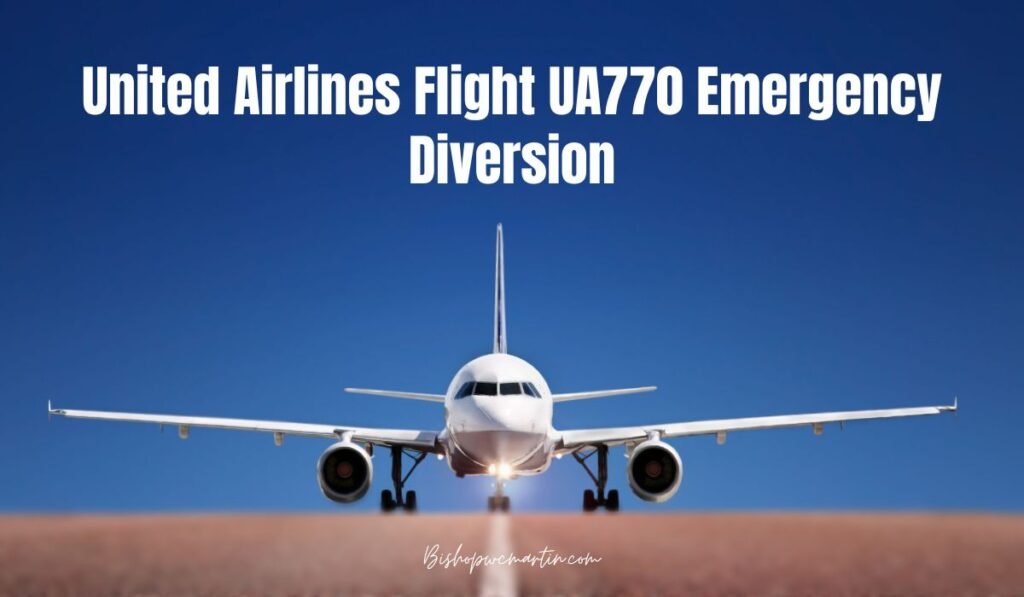Introduction: A Flight That Took an Unexpected Turn
Air travel is often seen as routine—people board, flights depart, and planes arrive safely at their destinations. But every once in a while, something unusual happens that reminds us how dynamic and unpredictable aviation can be. One such event was the United Airlines Flight UA770 emergency diversion, an incident that drew attention from passengers, aviation enthusiasts, and the media alike.
United Airlines, one of the largest carriers in the United States, operates hundreds of flights daily across the globe. Flight UA770, however, didn’t go exactly as planned. Instead of sticking to its scheduled route, the aircraft was forced to divert unexpectedly, sparking questions, curiosity, and even speculation about what caused the change.
In this article, we’ll break down everything you need to know about the emergency diversion of United Airlines Flight UA770. From the possible reasons behind the incident to how airlines and crews handle such situations, we’ll explore the bigger picture of what happens when an aircraft doesn’t follow its intended path.
Understanding Flight Diversions in Aviation
Before diving into the specifics of United Airlines Flight UA770 Emergency Diversion, it’s important to understand what an emergency diversion really means. Contrary to how dramatic it may sound, not every diversion is a crisis. In fact, diversions are fairly common in aviation, though they’re not always publicized.
A diversion occurs when a plane cannot safely or practically continue to its intended destination. This can happen for a variety of reasons: medical emergencies, mechanical issues, severe weather conditions, or even security concerns. Pilots are trained to make quick and rational decisions in these scenarios, prioritizing passenger safety above all else.
For airlines like United, diversions are inconvenient but necessary precautions. They often involve additional costs, delayed schedules, and logistical challenges, but they serve one crucial purpose—ensuring that everyone on board arrives safely, even if not at the planned airport.
The Timeline of United Airlines Flight UA770 Emergency Diversion
When United Airlines Flight UA770 Emergency Diversion experienced its emergency diversion, passengers quickly noticed something was amiss. For many, the first clue came from the flight tracking apps, which showed the aircraft veering off its original course. Others realized the change once the captain made an announcement explaining the situation.
The flight, originally scheduled to operate on a set route, had to divert to a different airport mid-journey. For those on board, this created mixed emotions—some felt anxious, others frustrated, and a few perhaps relieved that safety was prioritized. Meanwhile, for the crew, it meant switching into emergency protocol mode, coordinating with air traffic control, and reassuring passengers throughout the unexpected detour.
Though the diversion made headlines, it’s worth noting that the event was handled professionally and effectively. Diversions like this demonstrate just how well-trained airline crews are when it comes to managing unplanned events.
Possible Causes Behind the Diversion
The big question many asked after United Airlines Flight UA770 Emergency Diversion was: why did it happen? While United Airlines didn’t release every single detail, aviation experts often point to a few common causes of such situations.
1. Mechanical or Technical Issues
Airplanes are incredibly complex machines, and even minor technical issues can prompt diversions. This doesn’t always mean the aircraft was in immediate danger, but airlines prefer to err on the side of caution. Something as small as a faulty sensor or warning light can lead to a diversion.
2. Medical Emergencies
It’s not uncommon for passengers to experience medical issues mid-flight. In cases where someone’s health is at serious risk, the crew may decide to land at the nearest suitable airport so the individual can receive immediate medical attention.
3. Weather Conditions
Weather plays a massive role in aviation. Storm systems, turbulence, or unexpected conditions at the destination can all force a change United Airlines Flight UA770 Emergency Diversion in flight plans. If visibility drops or crosswinds become dangerous, pilots may choose to divert.
4. Security Concerns
Though rare, security issues can also lead to emergency diversions. These might involve disruptive passengers, potential threats, or anything else that compromises the safety of the cabin.
For Flight UA770, the most likely explanation involved either a technical issue or a passenger-related emergency, both of which are among the most common reasons for diversions in the industry.
How the Crew Handled the Situation
When an emergency diversion occurs, the crew’s response is critical. On United Airlines Flight UA770, reports indicate that both the pilots and cabin crew managed the situation with professionalism and calmness.
The pilots had to quickly assess the situation, weigh their options, and decide on the nearest suitable airport for landing. These decisions are not made lightly—they involve factors like runway length, available facilities, and weather conditions at alternate airports. Communication with air traffic control becomes constant during this process, ensuring that the diversion is carried out smoothly and safely.
Meanwhile, flight attendants play a vital role in keeping passengers calm. On a flight like UA770, it’s likely that the crew made multiple announcements, reassured travelers, and answered questions to ease concerns. In aviation, clear communication is the key to avoiding panic, and United’s crew handled this with expertise.
Passenger Reactions and Experiences
For passengers, a diversion can be stressful. Many people board flights with the expectation of reaching their destination on time, whether for United Airlines Flight UA770 Emergency Diversion meetings, family reunions, or vacations. When Flight UA770 diverted, reactions varied across the cabin.
Some passengers may have been worried about their personal safety, especially if the word “emergency” was used. Others, more seasoned travelers, likely understood that diversions are precautionary measures rather than signs of impending danger. There were also practical concerns—missed connections, rearranged plans, and the hassle of waiting for updates from the airline.
That being said, many passengers later expressed appreciation for how the situation was handled. Knowing that the airline prioritized safety above punctuality United Airlines Flight UA770 Emergency Diversion gave travelers peace of mind, even if it meant inconvenience in the short term.
The Aftermath: What Happens After a Diversion
When a flight like UA770 diverts, the incident doesn’t end once the plane lands. There’s a whole process that follows, both for the airline and the passengers.
First, ground crews must take over. If the diversion was due to a technical issue, maintenance teams inspect the aircraft thoroughly before it’s cleared to fly again. If it was a medical emergency, paramedics and hospital staff step in to provide care.
For passengers, the airline typically arranges alternative travel plans. This could mean rebooking on the next available flight, providing hotel accommodations if delays are extensive, or organizing ground transportation in some cases. While frustrating, these measures aim to minimize the impact on travelers.
United Airlines, like most major carriers, has protocols in place for such scenarios. They balance customer care with operational efficiency, ensuring that diverted flights don’t cause extended chaos across their schedules.
Lessons Learned From United Airlines Flight UA770 Emergency Diversion
Every diversion in aviation is a learning opportunity. For Flight UA770, the incident underscored a few important lessons for passengers and airlines alike.
- Safety comes first. No matter the inconvenience, the fact that the flight diverted demonstrates a commitment to keeping passengers safe above all else.
- Flexibility is key. Travel plans don’t always go as expected, and passengers who remain adaptable tend to handle diversions with less stress.
- Communication matters. Clear and transparent updates from the crew help keep everyone calm, even when plans change suddenly.
The event also served as a reminder that flying, while one of the safest modes of transportation, involves real-time decision-making and adaptability.
Aviation Industry Perspective on Diversions
From the aviation industry’s point of view, diversions like that of United Airlines Flight UA770 are considered part of standard operating procedures. While they may seem dramatic to passengers, airlines view them as necessary safety protocols.
Airlines invest heavily in training pilots and cabin United Airlines Flight UA770 Emergency Diversion crews to handle these situations. Flight simulators regularly include diversion scenarios, ensuring that pilots are prepared to make fast, informed decisions. Additionally, collaboration between airlines, airports, and regulatory bodies ensures that diversions can be managed efficiently.
In fact, many industry experts argue that diversions highlight the strength of modern aviation systems. Instead of seeing them as failures, they are proof that protocols work exactly as intended.
Final Thoughts: Why United Airlines Flight UA770 Emergency Diversion Matters
The emergency diversion of United Airlines Flight UA770 wasn’t just a random inconvenience—it was a real-world demonstration of aviation safety in action. While passengers may have faced delays and disruptions, the incident proved once again that airlines prioritize people over punctuality.
Flight diversions, while unsettling, are not signs of danger but rather examples of careful decision-making. Pilots, crews, and airlines train for these very moments, and when they occur, they reveal just how effective those systems really are.



